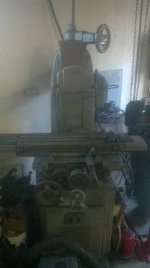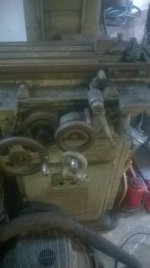Dave Rynearson
Plastic
- Joined
- Nov 19, 2017
Any thoughts about this machine for a possible rehab? Have always wanted one. Maybe this may be more doable than I the flather lathe I posted previously. Thanks.
Brown]craigslist | Page Not Found And Sharpe Surface Grinder No 2 - tools - by owner - sale[/url]
CL
worcester >
for sale >
tools - by owner
post account
◀ prev ▲ next ▶
reply ✉ ☎ x prohibited[?] Posted 10 days ago
favorite this post Brown And Sharpe Surface Grinder No 2 - $500 (North Brookfield) hide this posting
image 4 of 4
1
1 2 3 4
© craigslist - Map data © OpenStreetMap
28 Bell St
(google map)
make / manufacturer: Brown & Sharpe
model name / number: No 2
more ads by this user
Selling a Brown & Sharp Surface Grinder No. 2 with auto feed mechanism. It is in decent shape but could use to be cleaned up. Comes with a large magnetic vice and other various small items.
$500.00 obo
do NOT contact me with unsolicited services or offers


post id: 6395908771 posted: 10 days ago updated: 2 days ago email to friend ♥ best of [?]
safety tips
prohibited items
product recalls
avoiding scams
Avoid scams, deal locally Beware wiring (e.g. Western Union), cashier checks, money orders, shipping.
© craigslist help safety privacy feedback cl jobs terms about mobile
Brown]craigslist | Page Not Found And Sharpe Surface Grinder No 2 - tools - by owner - sale[/url]
CL
worcester >
for sale >
tools - by owner
post account
◀ prev ▲ next ▶
reply ✉ ☎ x prohibited[?] Posted 10 days ago
favorite this post Brown And Sharpe Surface Grinder No 2 - $500 (North Brookfield) hide this posting
image 4 of 4
1
1 2 3 4
© craigslist - Map data © OpenStreetMap
28 Bell St
(google map)
make / manufacturer: Brown & Sharpe
model name / number: No 2
more ads by this user
Selling a Brown & Sharp Surface Grinder No. 2 with auto feed mechanism. It is in decent shape but could use to be cleaned up. Comes with a large magnetic vice and other various small items.
$500.00 obo
do NOT contact me with unsolicited services or offers



post id: 6395908771 posted: 10 days ago updated: 2 days ago email to friend ♥ best of [?]
safety tips
prohibited items
product recalls
avoiding scams
Avoid scams, deal locally Beware wiring (e.g. Western Union), cashier checks, money orders, shipping.
© craigslist help safety privacy feedback cl jobs terms about mobile






